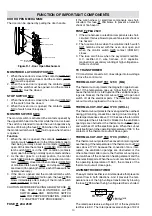
18
M
CONTROL PANEL ASSEMBLY TEST
The touch control panel consists of circuits including semiconductors such as LSI, ICs, etc. Therefore,
unlike conventional microwave ovens, proper maintenance can not be performed with only a voltmeter
and ohmmeter.
In this service manual, the touch control panel assembly is divided into two units, Control Unit and Key
Unit, and also the Control unit is divided into two units, CPU unit and Power unit, and troubleshooting
by replacement is described according to the symptoms indicated.
1. Key Unit Note : Check key unit ribbon connection before replacement.
The following symptoms indicate a defective key unit. Replace the key unit.
a) When touching the pads, a certain pad produces no signal at all.
b) When touching a number pad, two figures or more are displayed.
c) When touching the pads, sometimes a pad produces no signal.
2. Control Panel
The following symptoms indicate a defective control unit. Before replacing the control unit perform
the key unit test (Procedure N) to determine if control unit is faulty.
2-1 In connection with pads
a) When touching the pads, a certain group of pads do not produce a signal.
b) When touching the pads, no pads produce a signal.
2-2 In connection with indicators
a) At a certain digit, all or some segments do not light up.
b) At a certain digit, brightness is low.
c) Only one indicator does not light up.
d) The corresponding segments of all digits do not light up; or they continue to light up.
e) Wrong figure appears.
f) A certain group of indicators do not light up.
g) The figure of all digits flicker.
2-3 Other possible troubles caused by defective control unit.
a) Buzzer does not sound or continues to sound.
b) Clock does not operate properly.
c) Cooking is not possible.
d) Proper temperature measurement is not obtained.
3. If the fuse F2 F8A is blown, there could be shorts in the asymmetric rectifier or there is a ground
in wire harness. A short in the asymmetric rectifier may be occurred due to short or ground in H.V.
rectifier, magnetron, high voltage transformer or H.V. wire. Check them and replace the defective
parts or repair the wire harness.
CARRY OUT 4R CHECKS.
CAUTION:
Only replace fuse
F2 F8A
with the correct value replacement.
L
GRILL HEATING ELEMENTS (TOP) AND CONVECTION HEATING ELEMENT TEST
CARRY OUT 3D CHECKS.
Before carrying out the following tests make sure the heating element is cool completely.
1. Resistance of heating element.
Disconnect the wire leads to the heating element to be tested. Using ohmmeter with low resistance
range. Check the resistance across the terminals of the heating element as described in the
following table.
Table: Resistance of heating element
Parts name
Resistance
Grill heating elements GH (top)
Approximately 44.4
Ω
(22.2
Ω
x 2)
Convection heating element CH
Approximately 42.5
Ω
2. Insulation resistance.
Disconnect the wire leads to the heating element to be tested. Check the insulation resistance
between the element terminal and cavity using a 500V - 100M
Ω
insulation tester. The insulation
resistance should be more than 10 M
Ω
in the cold start.
If the results of above test 1 and/or 2 are out of above specifications, the heating element is probably
faulty and should be replaced.
CARRY OUT 4R CHECKS.
TEST PROCEDURES
PROCEDURE
LETTER
COMPONENT TEST
















































